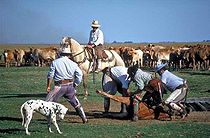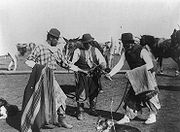Gaucho


Gaucho (gaúcho in Portuguese, gaucho in Spanish) is a term commonly used to describe residents of the South American pampas, chacos or Patagonian grasslands, found principally in parts of Argentina, Uruguay, Southern Chile and Rio Grande do Sul, the southernmost state of Brazil. In Brazil it is currently used to designate people from the state of Rio Grande do Sul.
The word gaucho could be described as a loose equivalent to the North American "Cowboy". Like the North American word cowboy, Venezuelan or Colombian llanero, or Chilean huaso, or the Mexican vaquero, the term often connotes the 19th century more than the present day; then gauchos made up the majority of the rural population, herding cows and practicing hunting as their main economic activities.
There are several conflicting hypotheses concerning the origin of the term. It may derive from the Mapuche cauchu ("vagabond")[1] or from the Quechua huachu ("orphan"), which gives also a different word in Spanish "guacho". The first recorded uses of the term date from around the time of Argentine independence in 1816.
Contents |
History


Gauchos were generally nomadic and lived on the pampas, the plain that extends north from Patagonia, bounded on the west by the Andes and extending as far north as the Brazilian state of Paraná. Residing outside of the growing urban centres and farming settlements, these skilled riders lived off the land often willingly sharing their food with other travelers. Most gauchos were either criollo (South Americans of Spanish ancestry) or mestizo (of mixed Spanish and Native American blood), but the term applies equally to people of other European, African, or mixed ancestry.
Some gauchos were recorded as being in the Falkland Islands/Islas Malvinas [1], and have left a few Spanish words in the local dialect e.g. camp from campo.
The gaucho plays an important symbolic role in the nationalist feelings of this region, especially that of Argentina and Uruguay. The epic poem Martín Fierro by José Hernández used the gaucho as a symbol against corruption and of Argentine national tradition, pitted against Europeanising tendencies. Martín Fierro, the hero of the poem, is drafted into the Argentine military for a border war, deserts, and becomes an outlaw and fugitive. The image of the free gaucho is often contrasted to the slaves who worked the northern Brazilian lands. Further literary descriptions are found in Ricardo Güiraldes' Don Segundo Sombra.
Like the North American cowboys, gauchos are generally reputed to be strong, honest, silent types, but proud and capable of violence when provoked. There is, perhaps, more of an air of melancholy about the classic gaucho than the classic cowboy.
Also like the cowboy, the gauchos were and still are proud and great horseriders. Typically, a gaucho's Horse constituted most of what he owned in the world. During the wars of the 19th century in the Southern Cone, the cavalries on all sides were composed almost entirely of gauchos. In Argentina, gaucho armies such as that of Martín Miguel de Güemes, slowed Spanish advances. Furthermore, many caudillos relied on gaucho armies to control the Argentine provinces.
The gaucho diet was composed almost entirely of beef while on the range, supplemented by yerba mate, an herbal tea-like drink rich in caffeine and nutrients. Argentine cooking draws influence from the simple but delicious recipes used in gaucho meals.
Gauchos dressed quite distinctly from North American cowboys, and used boleadoras (three leather bound rocks tied together with approximately three feet long leather straps) in addition to the familiar "North American" lariat or riata. The typical gaucho outfit would include a poncho (which doubled as saddle blanket and also as sleeping gear), a facón (large knife), a rebenque (leather whip), and loose-fitting trousers called bombachas, belted with a tirador, or a chiripá, a piece of cloth used in the fashion--but not the function--of a diaper. Several of these items were British imports into the area; for example, bombachas were originally made in Turkey. In the wintertime, gauchos wore heavy wool ponchos to protect against cold.
Modern influences

Gaucho is also the common denomination of the current inhabitants of the Brazilian State of Rio Grande do Sul. The term is also used to identify those people who live on the Austral States of the Southern Brazil, as well many others in Argentina, and Uruguay. This denomination is a heritage and expresses a code of living. Too much more than the pride one could has for its origins as immigrants to untouched lands and for the hard-working nature it represents. Indeed, a Gaucho still being today a proud way of existence. Gauchito (a boy in the Argentine colors and a gaucho hat) was the mascot for the 1978 FIFA World Cup.
In Popular Culture
- "The Gaucho" was a 1927 film starring Douglas Fairbanks. In it he plays the Gaucho, a heroic leader of a gang of outlaws that try to save a city overtaken by an evil general.
- La Guerra Gaucha was a 1942 Argentine film documenting the Gaucho war in Argentina in 1817. It is considered a classic of Argentine cinema.
- DC Comics owns two characters named El Gaucho. One was a Wonder Woman villain equipped with a flying robot horse and an electric lasso (from Wonder Woman #263) and the other one is an Argentinian masked hero (see Batmen of All Nations).
- "Gaucho" is the name of the 1980 album by American jazz fusion/rock band Steely Dan, which featured a song by the same name.
- The mascot of the University of California, Santa Barbara is the "Gaucho."
See also
- Hacienda system
- Gaucho literature
- Rebenque, the gaucho riding whip
- The Taba Game
- Estancias
- Pato
- Florencio Molina Campos
- Gauchito Gil
- Vaquero
- Cowboy (U.S.A)
- Morochuco (Peruvian Andean cowboy)
- Piajeno (north coast mule rider of Peru: Piura and Lambayeque)
- Charro (Mexican cowboy, nomad and bandolero)
- Guajiro (Cuban cowboy)
- Huaso (Chilean cowboy)
- Stockman